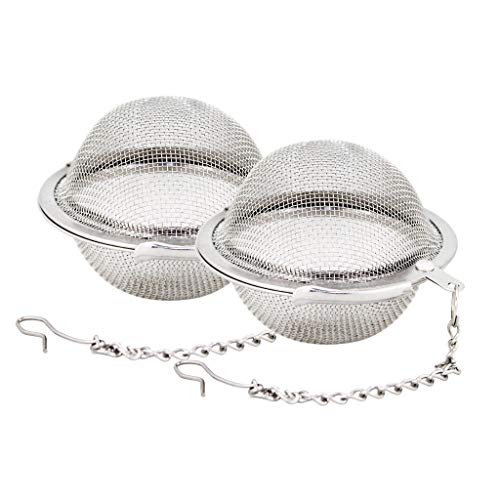10 Best Tea Ball Infuser Reviewed
Unlock the essence of tea perfection with our curated selection of the best tea ball infusers. We've meticulously sifted through the market to present you with the finest options, each promising a seamless infusion experience. From durable stainless steel to charming novelty designs, these infusers blend functionality with style. Say goodbye to tea debris and hello to pure, flavorful brews. Join us as we unveil the top contenders to elevate your tea journey.
Compare Products
- KR Score9.6
Kitchensradar.com established a ranking system called KR Score. KR Score is unaffected or unrelated to any websites run by manufacturers or sales agents. Learn more
- BrandReinmoson
- KR Score9.6
Kitchensradar.com established a ranking system called KR Score. KR Score is unaffected or unrelated to any websites run by manufacturers or sales agents. Learn more
- BrandOXO
- KR Score9.6
Kitchensradar.com established a ranking system called KR Score. KR Score is unaffected or unrelated to any websites run by manufacturers or sales agents. Learn more
- BrandOhtomber
- KR Score9.2
Kitchensradar.com established a ranking system called KR Score. KR Score is unaffected or unrelated to any websites run by manufacturers or sales agents. Learn more
- BrandOXO
- KR Score9.0
Kitchensradar.com established a ranking system called KR Score. KR Score is unaffected or unrelated to any websites run by manufacturers or sales agents. Learn more
- BrandLEVLOVS
- KR Score9.0
Kitchensradar.com established a ranking system called KR Score. KR Score is unaffected or unrelated to any websites run by manufacturers or sales agents. Learn more
- BrandJEXCULL
- KR Score9.0
Kitchensradar.com established a ranking system called KR Score. KR Score is unaffected or unrelated to any websites run by manufacturers or sales agents. Learn more
- BrandNorpro, Inc.
- KR Score8.8
Kitchensradar.com established a ranking system called KR Score. KR Score is unaffected or unrelated to any websites run by manufacturers or sales agents. Learn more
- BrandExptolii
- KR Score8.6
Kitchensradar.com established a ranking system called KR Score. KR Score is unaffected or unrelated to any websites run by manufacturers or sales agents. Learn more
- BrandOXT
- KR Score8.2
Kitchensradar.com established a ranking system called KR Score. KR Score is unaffected or unrelated to any websites run by manufacturers or sales agents. Learn more
- BrandFu Store
Last update on 2024-06-09 / Affiliate links / Images, Product Titles, and Product Highlights from Amazon Product Advertising API
Tea infusers are worth it for many tea enthusiasts who prefer loose leaf tea over tea bags. They offer several benefits, including better control over the brewing process, enhanced flavor extraction, and the ability to customize tea blends. Additionally, using a tea infuser allows for a more environmentally friendly brewing method compared to disposable tea bags. While there may be an initial investment in purchasing a tea infuser, the long-term savings and improved tea-drinking experience often make it worthwhile for those who appreciate the art of brewing loose leaf tea.
What is the difference between a tea strainer and an infuser?
The primary difference between a tea strainer and an infuser lies in their design and function during the brewing process. A tea strainer typically consists of a fine mesh or perforated material stretched over a small bowl or handle. Its purpose is to strain out loose tea leaves or herbs from the brewed tea when pouring it into a cup. In contrast, a tea infuser, also known as a tea ball or tea egg, is a container specifically designed to hold loose tea leaves or herbs during the steeping process. It usually has a perforated or mesh surface to allow water to flow through while containing the tea leaves inside during brewing. Essentially, a tea strainer is used after brewing to strain out leaves, while an infuser is used during brewing to contain the leaves.
What is the best material to steep tea in?
The best material for steeping tea depends on personal preference and specific considerations. Common materials for tea steeping include stainless steel, ceramic, glass, and certain types of high-quality plastic. Each material has its own benefits and considerations. Stainless steel is durable and retains heat well, while ceramic is known for its heat retention and aesthetic appeal. Glass allows you to observe the tea as it steeps, and certain plastics are heat-resistant and easy to clean. Ultimately, choose a material that aligns with your preferences for heat retention, durability, and visual aesthetics.
What material keeps tea hot the longest?
Materials like ceramic and porcelain are known for their excellent heat retention properties, making them suitable for keeping tea hot for an extended period. Double-walled stainless steel or vacuum-insulated travel mugs are also excellent choices for retaining heat, as they create a barrier between the tea and the external environment, preventing heat loss. Additionally, materials like cast iron and certain types of clay, such as Yixing clay, are prized for their ability to retain heat, making them popular choices for traditional tea brewing methods like gongfu cha. Ultimately, the material that keeps tea hot the longest will depend on factors such as insulation properties, thickness, and the design of the tea vessel.
How do you steep tea with a tea ball?
Steeping tea with a tea ball is a straightforward process:
-
Prepare the tea ball: Open the tea ball by unscrewing or unlatching it, then place the desired amount of loose tea leaves inside. Be careful not to overfill the tea ball to allow room for the leaves to expand during brewing.
-
Close the tea ball: Securely close the tea ball, ensuring that it is tightly sealed to prevent tea leaves from escaping during steeping.
-
Heat water: Boil water to the appropriate temperature for the type of tea you're brewing.
-
Place the tea ball in your mug or teapot: Once the water reaches the desired temperature, place the closed tea ball into your mug or teapot.
-
Pour water over the tea ball: Carefully pour the hot water over the tea ball, ensuring that the leaves are fully submerged.
-
Steep: Allow the tea to steep for the recommended time, typically 2-5 minutes, depending on the type of tea and your preference for strength.
-
Remove the tea ball: Once the tea has finished steeping, carefully remove the tea ball from the mug or teapot.
-
Enjoy: Your tea is now ready to be enjoyed! You can drink it directly from the mug or pour it into another cup if desired.
Related Posts:
Best Tea Infuser: An Expert Guide
The 10 Best Tea Ball Of 2024 For Your Kitchen
10 Best Loose Tea Infuser, Top Reviews
The Best Tea Infuser Mug, Top Features




























